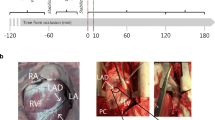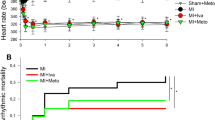Summary
The haemodynamic changes during intravenous amiodarone administration in laboratory animals and human studies are reviewed and compared with the results from our investigations
While the results of previous human studies have been rather variable, our investigations suggest that the cardiovascular changes following intravenous amiodarone include an early and usually short reduction of systemic and coronary vascular resistance, which may be partially due to the vasodilating properties of the solvent, polysorbate 80, As a result, a decrease in afterload and cardiac work and increases in cardiac output and coronary blood flow occur, Contrary to the observations in the animal experiments, heart rate increases in man, presumably as a result of the relatively greater fall in afterload which occurs
However, in spite of this increase in heart rate, contractility is reduced at the end of amiodarone administration and remains depressed after the infusion, resulting in a significant increase in left ventricular filling pressure, Neither myocardial oxygen demand nor consumption change during amiodarone administration
Although the intrinsic negative inotropic effects of amiodarone warrant a cautious approach in patients with left ventricular dysfunction, worsening of heart failure or the occurrence of myocardial ischaemia has been reported in only very few cases so far, In contrast, the drug was demonstrated to protect against pacing-induced myocardial ischaemia, in patients with both normal and depressed left ventricular function, These antiischaemic properties of amiodarone were investigated in a second study using a double pacing stress test protocol, Overall myocardial oxygen consumption did not change during pacing after amiodarone, but it clearly reduced (regional) myocardial ischaemia, as demonstrated by a reduction of ST-segment changes and anginal pain, and in particular by the absence of myocardial lactate production during pacing after amiodarone, These antiischaemic properties are mainly based on a reduction of myocardial oxygen demand, rather than on an improvement in coronary flow
It is concluded then, that amiodarone has significant haemodynamic effects as manifested by an early reduction in vascular resistance and a late negative inotropic effect, Although vasodilatation of short duration caused by its solvent, polysorbate 80, also occurs, the overall cardiovascular changes are caused by the direct, intrinsic haemodynamic effects of amiodarone alone, The important anti-ischaemic properties of amiodarone appear to result primarily from these cardiovascular actions and the inherent reduction in myocardial oxygen demand
Similar content being viewed by others
References
Bcnaim, R,; Denizcak J,P,; Melon J,; Domcngie B,: Kolsky H,: Chapelle, M, and Chiche, P,: Les effets antiarythmiques de l’amiodarone injectable, A propos de 100 cas, Archives des Maladies du Coeur et des Vaisseaux 69: 513–522 (1976)
Black, J,W,; Crowther A,F,; Shanks, R,G, and Smith, L,H,: A new adrenergic β-receptor antagonist, Lancet 1: 1080 (1964)
Broekhuysen, J,; Deltour G,; Ghislain, M, and Delbruyère M,: Recherches dans la séríe des benzofurannes, XXIX, Influence de l’amiodarone sur le métabolisme du coeur chez le chien, Biochemical Pharmacology 16: 2077–2084 (1967)
Charlier, R,: Cardiac actions in the dog of a new antagonist of adrenergic excitation which does not produce competitive blockade of adrenoceptors, British Journal of Pharmacology 39:668–674(1970)
Charlier, R,; Baudine, A,; Chaillel, F, and Dcltour, G,: Recherches dans la série des benzofurannes, XXV, Effets hémodynamiques de l’amiodarone chez le chien, Acta Cardiologica 22: 323–349 (1967)
Charlier,, R,; Deltour, G,; Baudine, A, and Chaillel, F,: Pharmacology of amiodarone, an anti-anginal drug with a new biological profile, Arzneimittel-Forschung 18: 1408–1417 (1968)
Charlier,, R,; Deltour, G,; Tondeur, R, and Binon, F,: Recherches dans la série des benzofurannes, VII, Etude pharmacologique préliminaire de butyl-2 (diiodo-3′, 5′ β-n-diéthy-aminoéthoxy-4′benzoyl)-3-benzofuranne, Archives Internationales de Pharmacodynamie et de Thérapie 139: 255–264 (1962)
Coté,, P,; Bourassa, M,G,: Délaye, J,; Janin, A,; Froment, R, and David, P,: Effects of amiodarone on cardiac and coronary hemodynamics and on myocardial metabolism in patients with coronary artery disease, Circulation 59: 1165–1172 (1979)
Deltour,, G,; Binon, F,: Tondeur, R,; Goldenberg, C; Henaux, F,: Sion R,: Deray E, and Charlier R,: Recherches dans la série des benzofurannes, VI, Activité coronarodilatatrice de dérivés alcoylés et amino-alcoxylés du benzoyl-3 benzofuranne, Archives Internationales de Pharmacodynamie et de Thérapie 139: 247–254 (1962)
Fauchier,, J,P,; Brochier, M, and Raynaud, R,: Etude clinique des effets antiarythmique ventriculaires de l’amiodarone (orale et injectable), Annales de Cardiologie et d’Angéiologie 22: 427–435 (1973)
Haas, H, and Haartfelder, G,: α, IsopropyI-α-(N-methyl-N-hom-overatryl-α-amino propyl)-3-4 dimelhoxyphenylacetonitril, eine Substanz mit coronargefarsen eigenschaften, Arzneimittel-Forschung 12: 549(1962)
Haffajee,, C: Love, J,; Dotierty, P,: Sloan, K, and Alnert, J,: Ventricular function before and during chronic amiodarone therapy in patients with symptomatic cardiac tachyarrhythmias, Circulation 68 (Suppl III): 280 (1983)
Heger, J,J,; Prystowsky, A,N, and Zipes, D,P,: Clinical efficacy of amiodarone in treatment of recurrent ventricular tachycardia and ventricular fibrillation, American Heart Journal 106(4): 887–894 (1983)
van Hoogenhuyze, D,; van de Burgh, P,; de Wilde, A,; Remme, W,J, and Krauss, X,H,: Acute effects of intravenous amiodarone in patients with complex ventricular dysrhythmias (abstract), American Journal of Cardiology 49: 1001 (1982)
Morady,, F,; Scheinman, M,M,; Shen, E,; Shapiro, W,; Sung, R,J, and Dicarlo, L,: Intravenous amiodarone in the acute treatment of recurrent symptomatic ventricular tachycardia, American Journal of Cardiology 51: 156–159 (1983)
Nademanee, K,; Hendrickson, J,: Kannan, R, and Singh, B,N,: Antiarrhythmic efficacy and electrophysiologic actions of amiodarone in patients with life-threatening ventricular arrhythmias: Potent suppression of spontaneously occurring tachyarrhythmias versus inconsistent abolition of induced ventricular tachycardia, American Heart Journal 103: 950–959 (1982)
Nademanee, K,; Singh, B,N,: Hendrickson, J,; Intarachot, V,; Lopez, B,: Feld, G,: Cannom, D,S, and Weiss, J,: Amiodarone in refractory life-threatening ventricular arrhythmias, Annals of Internal Medicine 98: 577–584 (1983)
Ourbak, P,; Rocher, R,: Aziza, J,P,: Manin, J,P,; Vagner, D,; Leclerc, M, and Maurice P,: Effets hémodynamiques de l’injection intra-veineuse de chlorhydrate d’amiodarone chez le sujet normal et le coronarien, Archives des Maladies du Coeur et des Vaisseaux 69: 293–298 (1976)
Pfisterer M,; Burkart, F,; Müller-Brand, J, and Kiowsky, W,: Amiodarone depresses cardiac function acutely but not chronically, (Abstract), Circulation 68 (Suppl, III): 281 (1983)
Remme,, W,J,; van Hoogenhuyze, D,C,A, and Kruyssen, H,A,CM,: Acute hemodynamic and anti-ischemic effects of intravenous amiodarone in man, (Abstract,) Circulation 68 (Suppl, III): 280 (1983)
Remme, W,J,; van Hoogenhuyze, D,C,A,; Strom, C,S,; Kruyssen, H,A, and Krauss, X,H,: Lactate extraction pattern during repeated ischemia in the human heart, (Abstract,) Journal of Molecular and Cellular Cardiology 13 (Suppl, 1): 76 (1981a)
Remme,, W,J,; Krauss, X,H,: Storm, C,S,; Kruyssen, H,A, and van Hoogenhuyze, D,C,A,: Assessment of lactate production during pacing-induced ischemia, (Abstract,) Journal of Molecular and Cellular Cardiology 13 (Suppl, I): 76 (1981b)
Remme,, W,J,; Krauss, X,H,; Storm, C,S,; Kruyssen, H,A,; van Hoogenhuyze, D,C,A, and Mantel, M,: Improved assessment of lactate production during pacing-induced ischemia, (Abstract,) European Heart Journal 2 (Suppl, A): 128 (1981c)
Rosenbaum, M,B,; Chiale, P,A, Halpern, M,S,; Nau, G,J,; Przybylski, J,; Levi, R,J,; Lazzari, J,O, and Elizari, M,V,: Clinical efficacy of amiodarone as an antiarrhythmic agent, American Journal of Cardiology 30: 934–944 (1976)
Schwartz,, A,; Shen, E,; Morady, F,; Gillespie, K,; Scheinman, M, and Chatterjee, K,: Hemodynamic effects of intravenous amiodarone in patients with depressed left ventricular function and recurrent ventricular tachycardia, American Heart Journal 106 (4): 848–856 (1983)
Sicart, M,; Besse, P,; Choussat, A, and Bricaud, H,: Action hémodynamique de l’amiodarone chez l’homme, Archives des Maladies du Coeur et des Vaisseaux 70: 219–227 (1977)
Singh B,N,; Jewitt D,E,; Downey J,M,; Kirk E,S, and Sonnenblick E,H,: Effects of amiodarone and L8040, novel antianginal and antiarrhythmic drugs, on cardiac and coronary hemodynamics and on cardiac intraceullular potentials, Clinical and Experimental Pharmacology and Physiology (Suppi 3): 427-442 (1976)
Vastesaeger, M,; Gillot, P, and Rason, G,: Etude clinique d’une nouvelle médication anti-angoreuse, Acta Cardiologica 22: 483–500 (1967)
Waxman H,L,; Groh, W,C,; Marchlinsky, F,E,; Buxton, A,E,; Sadowski, L,N,; Horowitz, L,N,; Josephson, M,E, and Kastor, J,A,: Amiodarone for control of sustained ventricular tachyarrhythmia: Clinical and electrophysiological effects in 51 patients, American Journal of Cardiology 50: 1066–1074 (1982)
Author information
Authors and Affiliations
Additional information
Amiodarone is marketed by Sanofi Labaz under the trademarks Cordarone (France), Cordarex (Germany), Cordarone-X (UK), Trangorex (Spain), Amiodar (Italy)
Rights and permissions
About this article
Cite this article
Remme, W.J., Diederik, C.A., van Dick, H. et al. Amiodarone. Molecular Diagnosis 29 (Suppl 3), 11–22 (1985). https://doi.org/10.2165/00003495-198500293-00003
Published:
Issue Date:
DOI: https://doi.org/10.2165/00003495-198500293-00003




